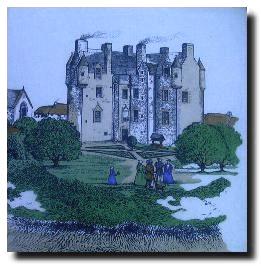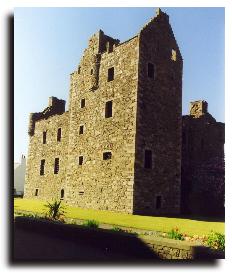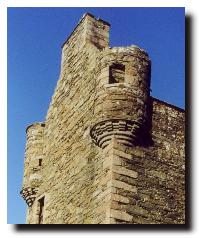 Built by Sir Thomas MacLellan of Bombie, Castle MacLellan is not a castle in the traditional sense but stands in the centre of the town of Kircudbright (pronounced Kirkoobray) opposite a row of local shops, in what is now known as the county of Dumfries and Galloway. It was built on the site of the convent of Greyfriars which had been established by King James II in 1449. Within nine years of the Reformation Act of 1560, Sir Thomas, the local Provost, acquired the site and the convent and used the buildings as a quarry for his new house. It was not built as a fortified castle (the gun loops are more a defense against potential robbers and riots rather than an invading army). But it was a house on a grand scale to impress the townspeople of its owners importance and prestige. In 1587 Sir Thomas entertained King James VI in Kircudbright and the king gave him a silver gun which is still in the local museum.
Built by Sir Thomas MacLellan of Bombie, Castle MacLellan is not a castle in the traditional sense but stands in the centre of the town of Kircudbright (pronounced Kirkoobray) opposite a row of local shops, in what is now known as the county of Dumfries and Galloway. It was built on the site of the convent of Greyfriars which had been established by King James II in 1449. Within nine years of the Reformation Act of 1560, Sir Thomas, the local Provost, acquired the site and the convent and used the buildings as a quarry for his new house. It was not built as a fortified castle (the gun loops are more a defense against potential robbers and riots rather than an invading army). But it was a house on a grand scale to impress the townspeople of its owners importance and prestige. In 1587 Sir Thomas entertained King James VI in Kircudbright and the king gave him a silver gun which is still in the local museum.
 Part of the main block rises to five floors and the castle was built to an L-plan design. There are two bartizans (corner turrets) and visitors can wander around the rooms inside this now roofless building. An armorial above the main entrance contains the arms of Sir Thomas and his wife, Dame Grissel Maxwell.
Part of the main block rises to five floors and the castle was built to an L-plan design. There are two bartizans (corner turrets) and visitors can wander around the rooms inside this now roofless building. An armorial above the main entrance contains the arms of Sir Thomas and his wife, Dame Grissel Maxwell.
Close by the castle is Greyfriar's Church. Little remains of the original medieval church after the Reformation but inside the modernised building is a monument to Sir Thomas and his wife.
There were MacLellans (with various spellings of the name) in Galloway from at least the 12th century and one of the witnesses to the charter for Sweetheart Abbey was "Cane McGillolane" and in the 14th century Gilbert McGillolane was described as "chief of the MacLellans". The MacLellans supported the local Balliols in the fight against Robert the Bruce. In the 15th century, the family's fortunes improved considerably, even to the extent of challenging the mighty Douglases at Threave Castle. But none of Sir Thomas' descendants took much interest in his splendid castle and by 1742 the contents were removed and the roof stripped off. In 1912 it entered state care and is now looked after by Historic Scotland.



